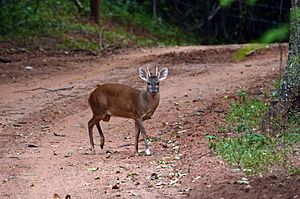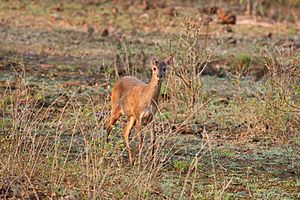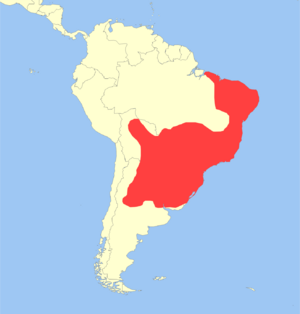Gray brocket facts for kids
Quick facts for kids Gray brocket |
|
|---|---|
 |
|
| Male | |
 |
|
| Young female The Pantanal, Brazil |
|
| Conservation status | |
| Scientific classification | |
| Genus: |
Mazama
|
| Species: |
gouazoubira
|
 |
|
| Synonyms | |
|
Mazama gouazoupira (lapsus) |
|
The gray brocket (Mazama gouazoubira), also known as the brown brocket, is a type of small deer. You can find it in many parts of South America. This includes northern Argentina, Bolivia, southern Peru, eastern and southern Brazil, Paraguay, and Uruguay.
Unlike some other brocket deer in its area, the gray brocket has fur that is gray-brown. It doesn't have reddish colors.
Contents
What's in a Name?
The scientific name for the gray brocket deer, Mazama gouazoubira, comes from a person named Félix de Azara. He was one of the first to describe these small deer in the Americas very well.
Azara called the red brocket "gouazoupita". For the gray brocket, he used "gouazoubira". This name has stayed with the deer's scientific name today. Sometimes you might see it spelled "gouazoupira", but that's a mistake. It probably happened by mixing up the "b" from the gray brocket's name with the "p" from the red brocket's name.
How to Spot a Gray Brocket
The fur of a gray brocket can be gray-brown or even dark brown. Deer living in open grasslands often have lighter, browner coats. Those in forest areas tend to have grayer, darker colors. Even within the same group, you might see different shades.
Their tails are white underneath. The hair on their sides is lighter than the rest of their body. A gray brocket deer can be about 85 to 105 centimeters (33 to 41 inches) long. They usually weigh between 11 and 25 kilograms (24 to 55 pounds).
Gray brockets are generally smaller than red brockets. It's harder to tell the difference between a gray brocket and an Amazonian brown brocket. However, the gray brocket has a more orange rump, bigger, rounder ears, and smaller eyes.
Where Gray Brockets Live
You can find the gray brocket in northern Argentina, Bolivia, southern Peru, eastern and southern Brazil, Uruguay, and Paraguay. They live from the western part of South America, near the East Andes mountains. From there, they spread eastward into areas like the Gran Chaco, Cerrado, and Caatinga, all the way to the Atlantic Ocean.
They do not live in the Amazon Rainforest region. Another type of deer, the Amazonian brown brocket, lives there instead. The gray brocket's home range goes south to the mouth of the Paraná River in Argentina.
These deer prefer areas with bushes and the edges of forests. They usually avoid wide-open spaces without cover and very thick forests.
Gray Brocket Behavior
What Gray Brockets Eat
Gray brockets are herbivores, meaning they eat plants. They are picky eaters but enjoy a wide variety of plants. Sometimes, they eat mostly fruits, depending on the season and what fruits are available. Even though they mostly avoid dense forests, they still find fruits there and other food sources.
In the dry season, they eat tough fruits from trees like Caesalpinia paraguariensis. They also eat cacti, bromeliad fruits, and leaves and roots from succulent plants. These foods help them get enough water.
Gray Brocket Reproduction and Life Cycle
Gray brockets become old enough to have babies around 18 months of age. They don't have a specific breeding season, so they can have babies any time of year. A mother deer's gestation period (how long she carries her baby) lasts about 7 months.
Soon after giving birth, the mother can become pregnant again. This means a gray brocket can have two babies in one year! After a baby is born, the mother takes care of it until it stops drinking her milk. The baby stays hidden during this time, and the mother feeds it.
How Gray Brockets Communicate
Gray brockets use scent marking to communicate. This means they leave their smell in different places. If a single gray brocket leaves many scent marks in one area, it can be a way to show that the territory belongs to them.
Other Habits
Gray brockets are active during the day. However, they usually only come out into open areas at night. They like to be alone and are territorial. Males defend a larger area, while females protect a smaller main area.
If they are kept in captivity, they are very shy and nervous unless they have a place to hide.
Gray Brocket Population and Conservation
Overall, the gray brocket is still common and found in many places. However, their numbers have gone down or they have disappeared near human towns. In Bolivia, their population seems stable even with a lot of hunting. In Brazil, they are the most common deer, but their numbers are decreasing in some areas.
In Argentina, their population is shrinking because they are losing their homes and are being hunted. In Paraguay, their numbers have dropped in places where many people live. People don't usually hunt gray brockets to control pests because these deer don't cause much damage to crops.
The gray brocket lives in 14 national and local reserves in Argentina. They are also in seven reserves in Bolivia, and many more in Paraguay and Brazil. Even though hunting is against the law in many places where gray brockets live, these laws are often not enforced.
To help stop their numbers from dropping, hunting laws need to be followed. Also, stray dogs from human areas should be controlled. Local villagers should learn about how to protect gray brocket populations. More studies are also needed to understand how many gray brockets there are, so we can better help them.
See also
 In Spanish: Venado para niños
In Spanish: Venado para niños


